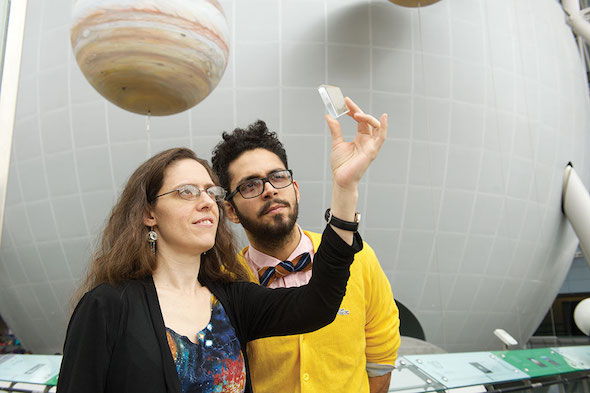
Ricardo Nunes was a medical student in Salvador, Brazil when he admitted it wasn’t the right path.
“I had always wanted to go into aerospace engineering,” he says. “It’s been my dream since I was 15 years old. I’m passionate about galaxies and stars. Knowing how the universe works helps us understand how life works.”
Today, Nunes is an engineering science major at BMCC. Through a stipend provided by the BMCC Scholarship Foundation, he’s taking part in a research project led by Professor K.E. Saavik Ford, whose interest in stars, like his, started early.
Growing up in Flushing, Queens, she often visited the Hayden Planetarium at the American Museum of Natural History, where she is now a Research Associate in the astrophysics department. She remembers being fascinated by constellations blinking from the planetarium’s curved ceiling, and photographs of the scarlet cloud of dust and gas known as the Orion Nebula.
Professor Ford’s current research focus is the Active Galactic Nuclei (AGN), or black holes expanding in the center of a galaxy.
“Ricardo is looking at spectra from real AGNs,” she says, explaining that active galaxies are bright enough to have their spectra measured by the Sloan Digital Sky Survey telescope in New Mexico.
“Spectra can be graphed showing the brightness of an AGN as the ‘y’ coordinate,” she says, “and the wavelength of the light as ‘x’.”
“Professor Ford is teaching me how to plot the data and giving me reference materials,” says Nunes. He is also looking for gaps in the wavelengths, suggesting there is a secondary black hole orbiting a galaxy’s central or supermassive black hole, a prediction made by Ford and others in a recent paper.
Black holes are collapsed stars whose gravitational pull is so strong, not even light can escape—so information gleaned from the light of a gaseous disc about to enter a black hole is of keen interest to scientists looking to understand the universe.
“Someday I want to be part of a research team looking at galaxies and stars,” says Nunes.
“Talking to graduate students at the museum, and being at BMCC has helped me become more outgoing in an academic setting. I always loved the idea of going where no one ever went before.”
EDITOR’S NOTE: To read more stories of faculty and student research project at BMCC, click HERE for the latest issue of Marks of Excellence, A Journal of Faculty and Student Excellence in Research and Learning.

